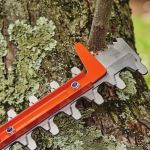Selecting the right hedge trimmer involves more than just comparing specs—testing its performance firsthand ensures it meets your needs for power, precision, and safety. With dozens of models on the market, a systematic testing approach helps identify top performers. Below is a detailed, professional guide to evaluating hedge trimmers across key criteria, ensuring you invest in a tool that delivers consistent results.
1. Ease of Use: Ergonomics & Intuitiveness
A trimmer’s usability directly impacts efficiency and user fatigue. Test these critical factors:
A. Handling & Balance
- Weight Distribution: Lift the trimmer with both hands (as you would during operation). A well-balanced tool (weight centered between the main handle and front grip) reduces arm strain—ideal balance ratios are 60:40 (front:rear) for gas trimmers and 50:50 for electric models.
- Grip Design: Check for rubberized, non-slip handles with ergonomic contours (e.g., curved grips for right/left-handed users). Models like the Stihl HSA 66 feature soft-grip inserts to minimize vibration transfer.
- Startup Ease:
- Gas Trimmers: Test pull-start effort (should require <30 lbs of force) and choke/purge knob accessibility.
- Electric Trimmers: Ensure trigger activation is smooth, with no sticking (common in low-quality switches).
B. Maneuverability
- Range of Motion: Trim a small hedge section, noting how easily the blade reaches vertical sides and horizontal tops. Adjustable handles (e.g., the Husqvarna 122HD’s swiveling front grip) improve access to awkward angles.
- Cord Management (Corded Models): Test with a 50-foot extension cord—does the cord hinder movement? A built-in cord hook (like the Black+Decker LHT2436) keeps cables out of the cutting path.
2. Cutting Performance: Power & Precision
The core function of a trimmer is clean, efficient cutting. Evaluate these performance metrics:
A. Hedge Type Versatility
- Soft vs. Woody Growth:
- Soft Hedges (e.g., privet, boxwood): Test speed and blade alignment—double-edge blades (common in electric trimmers) should leave <5% ragged cuts.
- Woody Stems (e.g., laurel, hawthorn): Gas trimmers with 20+ cc engines should slice through 1.5” stems in one pass; electric models may require 2–3 passes (acceptable for stems <1”).
- Dense Foliage Test: Trim a overgrown hedge section—does the motor stall (electric) or bog down (gas)? A quality gas trimmer (e.g., Echo HCA-2620) maintains RPM under load, while budget electric models may lose power.
B. Cutting Speed & Efficiency
- Throughput Test: Time how long it takes to trim a 10-foot hedge section (3ft height). A professional gas trimmer should complete this in <5 minutes; cordless electrics (20V, 4.0Ah battery) take 8–12 minutes.
- Blade Sharpness Retention: After 30 minutes of continuous use, inspect blade edges—premium steel blades (e.g., SK5 carbon steel) show minimal dulling, while low-grade blades may nick or bend.
C. Finish Quality
- Edge Straightness: Use a string line as a guide; the trimmer should follow within 0.5” of the line. Models with blade alignment markers (e.g., Worx WG251) simplify straight cuts.
- Surface Smoothness: Run your hand gently over the cut surface (wear gloves). High-quality trimmers leave <10% of stems uncut or torn; inferior models may leave a ragged texture due to blade misalignment or dullness.
3. Safety Features: Compliance & Functionality
Safety should never be compromised. Verify these OSHA and ANSI-compliant features:
A. Active Safety Systems
- Dual-Trigger Activation: The trimmer should require both the main trigger and a safety switch to operate (standard in 95% of modern models, including the DeWalt DCMHT820B).
- Automatic Power Cutoff: Release the trigger—blades should stop within 0.5 seconds (test with a stopwatch). Delayed shutdowns indicate faulty electrical components.
- Blade Guards: Check that the front guard is sturdy and covers at least 50% of the blade when not in use. Foldable guards (common in gas trimmers) should lock securely in the “on” position.
B. Hazard Mitigation
- Vibration Control: Measure vibration levels with a meter (ideal <2.5 m/s² for electric, <4.0 m/s² for gas). Excessive vibration (over 5 m/s²) can cause hand-arm vibration syndrome (HAVS) over time.
- Noise Levels: Use a decibel meter—corded electrics should register <95 dBA, cordless <90 dBA, and gas <100 dBA (OSHA requires hearing protection above 85 dBA).
4. Power Source Reliability: Corded, Cordless, or Gas?
Test based on the trimmer type to ensure power needs match your usage:
A. Cordless Trimmers (Battery-Powered)
- Runtime Test: Fully charge the battery and trim continuously until it dies. A 20V, 4.0Ah battery should last 45–60 minutes for light trimming; heavy use may reduce this to 25–30 minutes.
- Charge Time: Time from 0–100% charge. Premium chargers (e.g., Makita Rapid Optimum Charger) restore 80% charge in 30 minutes; budget chargers may take 2+ hours.
- Cold Weather Performance: Test in 40°F conditions—lithium-ion batteries lose 20–30% capacity in cold, so ensure the trimmer maintains power for at least 20 minutes.
B. Corded Trimmers
- Voltage Stability: Use a multimeter to check voltage at the outlet—120V models should maintain ±5% voltage during operation to prevent motor overheating.
- Cord Durability: Bend the power cord at sharp angles—rubber-sheathed, SJOW-rated cords (weatherproof, oil-resistant) are ideal for outdoor use.
C. Gas Trimmers
- Start Consistency: Attempt cold starts 3 times—successful starts should occur within 2 pulls (4-stroke) or 3 pulls (2-stroke). Hard starts indicate carburetor issues or poor fuel mix.
- Fuel Efficiency: Measure fuel consumption—30 cc gas trimmers should use <0.5 gallons per hour during moderate use. Excessive fuel use (over 0.75 gph) signals inefficient combustion.
5. Long-Term Maintenance & Durability
A trimmer’s lifespan depends on build quality and ease of upkeep. Evaluate these factors:
A. Build Materials
- Blade Quality: Look for Teflon-coated or chrome-plated blades (resist rust and sap buildup). Budget trimmers often use painted steel, which chips after 6 months of use.
- Motor Construction: Brushless motors (common in premium cordless models like EGO Power+ HT2400) last 50% longer than brushed motors, with less maintenance.
B. Service Accessibility
- Filter Replacement (Gas Models): Test how easily the air filter cover opens—screws should turn smoothly, and filters (foam or paper) should be replaceable without tools.
- Blade Removal: Use the included wrench to detach blades—process should take <2 minutes. Difficult blade changes indicate poor design (e.g., misaligned bolt holes).
6. Additional Testing Tips for Professionals
- Wet Cutting Test: Trim a damp hedge (post-rain) to check for electrical hazards (corded models) or blade slippage. IPX4-rated trimmers should handle light moisture without issue.
- Extended Use Test: Operate the trimmer for 90 minutes straight to assess heat buildup—gas engines should stay below 180°F; electric motors below 150°F (use an infrared thermometer).
- Warranty & Support: Verify warranty length (minimum 2 years for electric, 3 years for gas) and availability of replacement parts (e.g., OEM blades for Stihl trimmers are widely accessible).
Final Evaluation Checklist
Use this matrix to score trimmers across key criteria (1–5, with 5 being excellent):
| Criterion | Gas Trimmer Expectation | Electric Trimmer Expectation |
|---|---|---|
| Cutting Thick Stems (1.5”) | Cuts in 1 pass | Cuts in 2–3 passes (≤1” stems) |
| Runtime (Continuous Use) | Unlimited (fuel permitting) | 45+ minutes (20V, 4.0Ah battery) |
| Vibration Level | <4.0 m/s² | <3.0 m/s² |
| Safety Features Compliance | OSHA/ANSI certified | UL/CE certified |
| Ease of Blade Sharpening | Requires professional service | User-replaceable blades |
Conclusion: Test Like a Pro, Choose with Confidence
A thorough test ensures your hedge trimmer delivers on performance, safety, and durability. Prioritize your needs: power for commercial use, portability for residential yards, or precision for ornamental hedges. By evaluating ease of use, cutting performance, safety features, and power reliability, you’ll select a trimmer that not only meets but exceeds your expectations—transforming hedge maintenance into a streamlined, professional-grade task.
Always test with the actual hedge types you’ll trim, use manufacturer-recommended settings, and don’t hesitate to ask for demo units at hardware stores. With this guide, you’re equipped to identify the best hedge trimmer for your unique needs, ensuring years of efficient, safe, and beautiful results.

